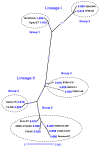Multi-locus sequence analysis of Mycoplasma capricolum subsp. capripneumoniae for the molecular epidemiology of contagious caprine pleuropneumonia
- PMID: 21756321
- PMCID: PMC3177781
- DOI: 10.1186/1297-9716-42-86
Multi-locus sequence analysis of Mycoplasma capricolum subsp. capripneumoniae for the molecular epidemiology of contagious caprine pleuropneumonia
Abstract
Mycoplasma capricolum subsp. capripneumoniae (Mccp) is the causative agent of contagious caprine pleuropneumonia (CCPP), a devastating disease of domestic goats. The exact distribution of CCPP is not known but it is present in Africa and the Middle East and represents a significant threat to many disease-free areas including Europe. Furthermore, CCPP has been recently identified in Tajikistan and China. A typing method with an improved resolution based on Multi-Locus Sequence Analysis (MLSA) has been developed to trace new epidemics and to elucidate whether the recently identified cases in continental Asia were due to recent importation of Mccp. The H2 locus, a polymorphic region already in use as a molecular marker for Mccp evolution, was complemented with seven new loci selected according to the analysis of polymorphisms observed among the genome sequences of three Mccp strains. A total of 25 strains, including the two new strains from Asia, were analysed by MLSA resulting in the discrimination of 15 sequence types based on 53 polymorphic positions. A distance tree inferred from the concatenated sequences of the eight selected loci revealed two evolutionary lineages comprising five groups, which showed good correlation with geographic origins. The presence of a distinct Asian cluster strongly indicates that CCPP was not recently imported to continental Asia. It is more likely that the disease has been endemic in the area for a long time, as supported by historical clinical descriptions. In conclusion, this MLSA strategy constitutes a highly discriminative tool for the molecular epidemiology of CCPP.
Figures



References
-
- Thomas P. In: Publication du gouvernement général civil de l'Algérie. Jourdan A, editor. Algiers; 1873. Rapport médical sur le Bou Frida.
-
- Abu-Groun EA, Taylor RR, Varsani H, Wadher BJ, Leach RH, Miles RJ. Biochemical diversity within the "Mycoplasma mycoides" cluster. Microbiology. 1994;140(Pt 8):2033–2042. - PubMed
-
- Bonnet F, Saillard C, Bove JM, Leach RH, Rose DL, Cottew GS, Tully JG. DNA relatedness between field isolates of Mycoplasma F38 group, the agent of contagious caprine pleuropneumonia, and strains of Mycoplasma capricolum. Int J Syst Bacteriol. 1993;43:597–602. doi: 10.1099/00207713-43-3-597. - DOI - PubMed
-
- Costas M, Leach RH, Mitchelmore DL. Numerical analysis of PAGE protein patterns and the taxonomic relationships within the "Mycoplasma mycoides cluster". J Gen Microbiol. 1987;133:3319–3329. - PubMed
Publication types
MeSH terms
Substances
Associated data
- Actions
- Actions
- Actions
- Actions
- Actions
- Actions
- Actions
- Actions
- Actions
- Actions
- Actions
- Actions
- Actions
- Actions
- Actions
- Actions
- Actions
- Actions
- Actions
- Actions
- Actions
- Actions
- Actions
- Actions
- Actions
- Actions
- Actions
- Actions
- Actions
- Actions
- Actions
- Actions
- Actions
- Actions
- Actions
- Actions
- Actions
- Actions
- Actions
- Actions
- Actions
- Actions
- Actions
- Actions
- Actions
- Actions
- Actions
- Actions
- Actions
- Actions
- Actions
- Actions
- Actions
- Actions
- Actions
- Actions
- Actions
- Actions
- Actions
- Actions
- Actions
- Actions
- Actions
- Actions
- Actions
- Actions
- Actions
- Actions
- Actions
- Actions
- Actions
- Actions
- Actions
- Actions
- Actions
- Actions
- Actions
- Actions
- Actions
- Actions
- Actions
- Actions
- Actions
- Actions
- Actions
- Actions
- Actions
- Actions
- Actions
- Actions
- Actions
- Actions
- Actions
- Actions
- Actions
- Actions
- Actions
- Actions
LinkOut - more resources
Full Text Sources
Molecular Biology Databases

